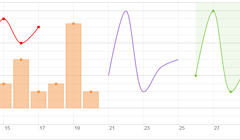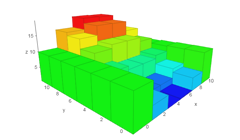
Network
Network is a visualization to display networks and networks consisting of nodes and edges. The visualization is easy to use and supports custom shapes, styles, colors, sizes, images, and more. To handle a larger amount of nodes, Network has clustering support. Network uses HTML canvas for rendering.

Timeline
The Timeline is an interactive chart to visualize data in time. The data items can take place on a single date, or have a start and end date (a range). Timeline uses regular HTML DOM to render the timeline and items put on the timeline. This allows for flexible customization using css styling.

Graph2d
Graph2d is an interactive visualization chart to draw data in a 2D graph. It can plot lines, point and bars. You can freely move and zoom in the graph by dragging and scrolling in the window.
Graph2d uses HTML DOM and SVG for rendering. This allows for flexible customization using css styling.

Graph3d
Graph3d is an interactive visualization chart to draw data in a three dimensional graph. You can freely move and zoom in the graph by dragging and scrolling in the window. Graph3d also supports animation of a graph. Graph3d uses HTML canvas to render graphs, and can render up to a few thousands of data points smoothly.
About & download; getting started
The vis.js library is developed by Almende B.V, as part of CHAP. Vis.js runs fine on Chrome, Firefox, Opera, Safari, IE9+, and most mobile browsers (with full touch support). This site contains documentation, downloads and live examples of vis.js. The sourcecode of vis.js is available at Github. For questions, issues, and suggestions please use the issues section of the Github project.
installing with npm
npm install vis
installing with bower
bower install vis
download zip (version 3.6.2)
Showcase; see vis in action!
In this section you can see cool projects that vis was used in. If you have made something and would like it featured, please make an issue on github with your project and how you'd like to be credited.
Contributing; join the project
Since vis.js is an open source project, everybody can contribute to it. If you want to contribute, great! Here's how:
First, fork vis on Github, then add your feature, fix a bug,
rephrase our writing etc. and do a pull request to the develop branch on Github!
Pull requests to the master branch will not be merged.
If you fork the codebase, you'll find all modules in seperate files. This makes it a lot easier to work on than the distributed and combined vis.js file.
If you want to contribute but don't know how, feel free to pick up a feature request described below!
These come from ourselves as well as from Github issues. If you do, please post an issue on Github letting us know, so we can mark the feature
under development as well as help out when needed. If we are about to implement something from the list, we'll remove it before starting.
Feature requests
We get a lot of feature requests on Github. Here's a list of them!
The requests that come in on Github usually have a good argumentation and a lot of these ideas have made it into vis! To keep a nice overview of them, to clean up
our Github issues and to supply a pool of ideas for people to contribute, we have made this list.
This is by no means an end-of-the-line for your feature, but just something that we cannot pick up right away or cannot use in our projects at this time.
We'd like to invite people who want to contribute to pick up one (or more!) of these features. View the list here.
Licenses
Copyright (C) 2010-2015 Almende B.V.
Vis.js is dual licensed under both Apache 2.0 and MIT.
Vis.js may be distributed under either license.
- http://www.apache.org/licenses/LICENSE-2.0
- -The MIT License http://opensource.org/licenses/MIT





